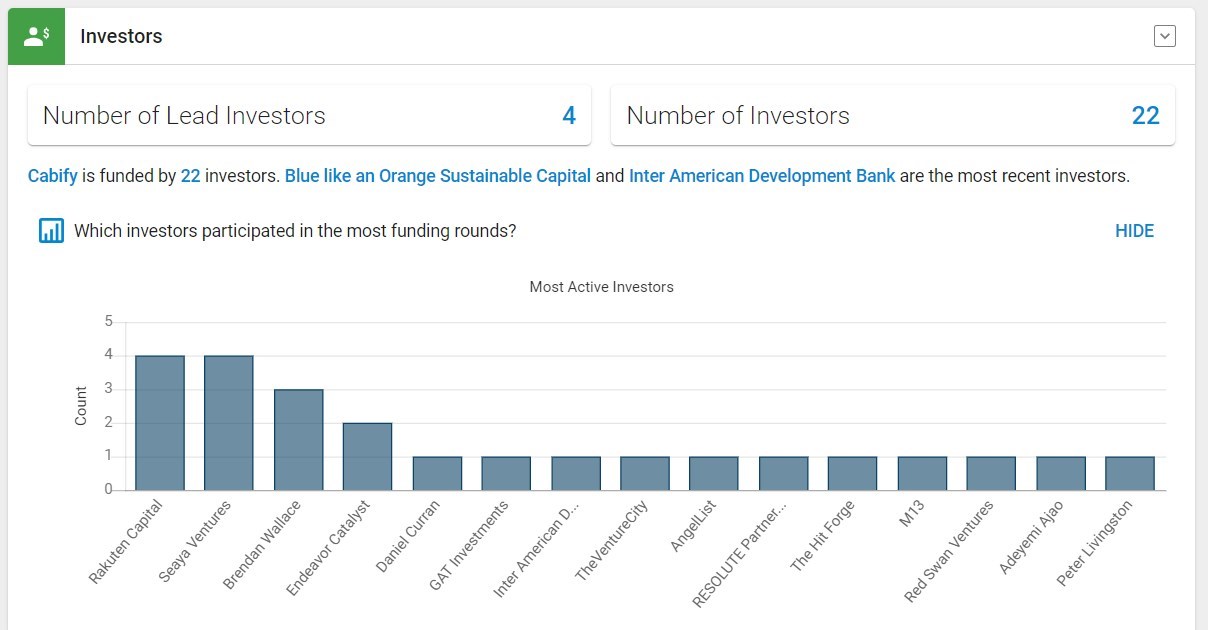Cabify is a ride-sharing company that operates in Latin America, Spain, and Portugal.
At Cabify, they make sure their customers – passengers and drivers – enjoy the ride. Charging a fair price, improving your door-to-door journey, making transport accessible to all are just some of the things they think are important. Why? Because they believe that by making transport better, they can make their cities and communities better.
Founded in 2011, the company is headquartered in Madrid, Madrid, Spain.
Investor Info


From Wikipedia
Cabify is a Spanish transportation network company. It provides vehicles for hire via its smartphone mobile app. Vehicles are driven by their owners[citation needed], who are self-employed service providers. Operating in Latin America, Spain, and Portugal, the company offers two services, one for businesses and another for individuals.[1][2][3]
As one of the biggest transportation network companies in the Spanish- and Portuguese-speaking world, Cabify operates in Mexico, Chile, Colombia, Peru, Brazil, Panama, Ecuador, Portugal, Spain, Argentina, Dominican Republic, and Uruguay. In early 2016, Cabify reported over one million installations globally, of which the majority were in Latin America and the rest in Spain.[4][5]
Cabify was founded in May 2011 by Juan de Antonio, a Spanish entrepreneur, telecommunications engineer, and graduate of Stanford University.[6] De Antonio was motivated to create a transportation network company after receiving negative market feedback (high upfront costs) when trying to introduce electric vehicles in European cities.[7][8]
De Antonio started discussing the idea with Adeyemi Ajao, one of the founders of Tuenti, and Brendan Wallace. Cabify set up their first transportation network in Madrid, and their idea attracted investors from Silicon Valley. Juan de Antonio stayed as the CEO, while Ajao and Wallace became advisors as they continued leading their own startup.[1][9]Samuel Lown joined as the CTO in July with Michael Koper and Adrian Merino joining the team two months later.[9]
In February 2012, only 6 weeks after its official launch, Cabify had signed up 20,000 users and completed nearly 3,000 rides in Madrid alone.[10] In the next two years, more than 150 taxi drivers in Madrid would join the company.[11] In September 2012, the company raised a $4 million Series Seed investment round from Black Vine, Belgian fund Emerge, angel investors sourced via AngelList (including the Winklevoss twins), and a series of Latin American investors.[12][13]
A year after its foundation in Spain, Cabify started doing business in Latin America, opening subsidiaries in Mexico, Chile and Peru.[14][15][16][17] Within a few years, 80% of Cabify’s income would come from the American continent.[8]
The company’s second investment round came in April 2014. The $8 million investment was led by Seaya Ventures.[18] By then, Cabify had more than 100,000 downloads of its apps globally, more than 35,000 of which were in Spain.[13]
Initially, the service was called “Executive” and was intended for a niche group, with high-end vehicles that were slightly more expensive than taxis. In June 2013, the company launched Cabify Lite, with mid-range vehicles that were usually cheaper than taxis. By the end of 2015, Cabify Lite represented 85% of the company’s offer.[19]
The company’s biggest investor, Japanese e-commerce giant Rakuten, which is also a lead investor in taxi-app player Lyft, made its first investment in Cabify in October 2015, when it provided capital for a further push into Latin America. Cabify’s revenues had risen to $40m, from $10m in 2014 and $1m in 2013.[20] The company had also partnered with Waze to complete its trips more quickly and improve driver and passenger safety.[21]
With the new investment, Cabify increased expansion in Mexico. The Hoy No Circula program in Mexico City generated a 200% increase in demand.[22] During that period, Cabify reduced its tariffs by 25% to motivate the inhabitants to use alternative means of transportation.[23] Also, it donated a part of its revenues to UNICEF.[24] At that time, the company operated in six Mexican cities: Mexico City, Monterrey, Querétaro, Puebla City, Guadalajara and Toluca.[25]
In April 2016, Rakuten invested $92 million more in Cabify. Rakuten’s investment was a part of a round of funding in which Cabify raised $120 million. The company announced it would start operating in Argentina (Buenos Aires and Rosario),[26] Brazil (Sao Paulo),[27] Costa Rica,[6] Portugal (Lisbon),[28] Bolivia, Ecuador, and Panama.[29] It also announced it would expand its current services to new cities, such as Valparaíso and Viña del Mar in Chile.[30]
When the company announced it would do business in Colombia, it was welcomed by the Association of Free Consumers.[31] Cabify started offering services to the corporate sector in Bogotá in 2015.[32] Cabify late opened in Cali in April 2016 and announced its expansion to Medellín and the Caribbean region, more precisely to the cities of Barranquilla and Cartagena. It planned to offer its services in Pereira, Manizales and Bucaramanga later in the year.[32]
The company operates in eight Spanish cities as of 2017 – Madrid, Barcelona, Valencia, Bilbao, Vitoria, A Coruña, Málaga, and Sevilla – and on the island of Tenerife.[33] After the 2016 financing, Cabify was valued at around $320 million. It currently has 400 permanent employees, across engineering, operations, sales, marketing, logistics and customer service.[4][8]
Cabify operates as the contact point between customers and private drivers by means of its mobile app for Android and iPhone, as well as its web page. Users pay for the service via their credit card or PayPal account, with cash payments introduced in 2016. The payment system is protected by Symantec‘s Verisign security.[34]
The service has been conceived as a premium-quality transportation alternative.[1] It offers three core classes of vehicles: Executive, with vehicles such as Mercedes S-Class or Audi A8, Lite (e.g. Toyota Avensis), or Group (6 persons).[33][35] In addition to these core services, Cabify offers a number of other services depending on the city, including: Cabify Express, a service of immediate delivery via moto taxis, in Peru; Cabify Taxi, a service for accessing local taxi cabs, in Spain; Cabify City, a service of independent drivers, in Chile; Cabify Bike, a service where users can ride with their bikes in Chile, and Cabify Cash, a service where users pay with cash instead of credit cards, in Peru.[36][37][8]
Cabify was the first private service to offer a transportation option for disabled persons. The service was first introduced in partnership with Peugeot in Mexico, where 6.6% of the population had some kind of disability.[38] Since then, the service has been opened in Chile, Spain and Peru. Cabify’s plans for the future include global expansion of Cabify Access, its service for the disabled.[8]
The company serves two client types: corporate and private passengers, with the former taking up 60% of Cabify’s offer. Cabify claims corporate users are the focus of the company’s service offering. The business-focused service, used for the transport of employees, includes big clients such as Google, Visa, Allianz, FCC, and Securitas Direct.[3][39]The company has extended its corporate relationships to secure commercial partnerships including LAN, the largest airline in Peru and Chile, Aeroméxico, the largest Mexican airline, and Visa credit cards.[40][41]
The company is trying to grow in a sound way by forging relationships with local businesses, hiring both traditional taxis and regular consumers as Cabify drivers, and placing heavy emphasis on repeat customers, for example by steering its cars in peak hours towards habitual users rather than those that offer the most lucrative one-off fare. Because of this approach, the company claims that it has no need to subsidize drivers or offer steep discounts to users, unlike many of its rivals.[12][20]
Mobile application
The app shows the location of drivers to the customer, calls the closest driver, directs the driver, and plays the role of intermediary for payments, taking a commission of around 20%. Once the ride is over, Cabify sends a summary to the customer’s mobile phone, including information such as the distance, duration and cost of the ride. The customer can evaluate the ride and the driver.[42] Locations can be saved as favorites to be accessed more easily. The system has a waiting queue, where it keeps looking for a ride over a period indicated by the customer (from 5 to 30 minutes). The service can be reserved up to 30 days in advance.[14]
The service includes the possibility of real-time tracking between departure and arrival. If the signal is lost for more than sixty seconds or the route changes considerably, the passenger will receive a telephone call verifying their comfort and safety.[43] The app allows the customer to choose the type of vehicle (Executive, Lite or Group), and offers a wide range of free options, such as the driver speaking a foreign language,[33] the desired air-conditioning temperature, the driver opening the door or calling upon arrival, and the desired radio station.[5]
The Cabify app also integrates with Waze to provide drivers with the best route possible.[44]
Drivers
Cabify cars and drivers pass a rigorous selection and filtration process. All drivers must pass psychometric tests, tests for alcohol and drugs, and a city orientation test. They must show they have no criminal record or traffic violations.[2] The murder of a young female customer in Puebla, Mexico, by one of Cabify’s drivers raises important questions about the credibility of any filtration process carried out by the company.[45]
All drivers are required to wear professional attire.[39] They are expected to be polite and attend to the needs of the passenger which oftentimes includes additional services such as in-car reading materials and Cabify-branded water.[35] Drivers are required to take the fastest way to the destination. If they change the route without the passenger’s approval, they can be penalized by Cabify.[34]
Legal position
Unlike some other competitors, Cabify tries to work with governments to find a way to operate legally.[20] The company has been successful thus far, operating legally in the countries where it is currently present.[46]
In the case of Spain, all the drivers work as “collaborators” for Cabify, and they do this under a commercial contract for the supply of services, either as part of a company or as freelance owners of a VTC vehicle fleet (Chauffeur Driven Vehicle).[47] They can be either the direct suppliers of the service or provide it through hired personnel under the Social Security’s legislation. Cabify doesn’t take care of the registration of self-employed workers. Instead, they need to be considered as such, before they begin to collaborate with the company. Cabify’s drivers don’t receive monthly or yearly fixed salaries from the company. Their income comes from the invoicing of journeys and the amount of services they have provided.[48][49]
Cabify’s control system allows them to keep track of all payments and charges that come from them because journeys are not allowed to be paid in cash. This helps eliminate the informal economy and the precariousness currently present in the rest of urban transportation’s segments.[50][51]
The taxi union of Santiago protested against Cabify and Uber, announcing a national strike in May 2016.[52] Several Chilean celebrities who use Cabify’s services, including Cristián Sánchez and Renata Ruiz, supported the company by filming a video where they give their reasons for using Cabify.[53] After trying to find a legal solution with the Chilean government for over six months without success, Cabify launched Cabify City, which connects independent car owners with users on the Cabify app. Cabify City is its first unregulated service.[37]
In May 9, 2017, the Colombian Superintendence of Ports and Transport fined Cabify $516 million Colombian pesos (about $173,240 United States dollars), as it “facilitated the transgression of transport laws stated by the Government of Colombia, by allowing personal transport services to operate in special transport vehicles that were not authorized by the Ministry of Transport for this modality of services”.[54]
Key differences
While it has been dubbed the “Uber of Europe”[10] and the “Spanish Uber”,[7] Cabify shows differences when compared with its main competitor, especially regarding its pricing policy.
Cabify charges per kilometer of the optimal route. This means that it optimizes the distance between two points so the passenger is paying for the most direct route regardless of the actual route chosen by the driver. Uber, in comparison, charges according to minutes and kilometers spent inside the vehicles.[34]
Moreover, Cabify has fixed pricing (Since December this was removed in the Brazilian territory), where the price per kilometer does not change depending on the time of the day. Uber, on the other hand, has dynamic prices, which change depending on peak hours, weather and local events.[26] Cabify described it as a socially motivated feature: “We are not something that the driver does in his free time. We are his main source of income. We don’t think it should be something occasional, but a job that can sustain a family.”[8]
A test drive performed by ABC in Madrid established that Cabify was cheaper than both Uber and city taxi service for the same trip.[55]

